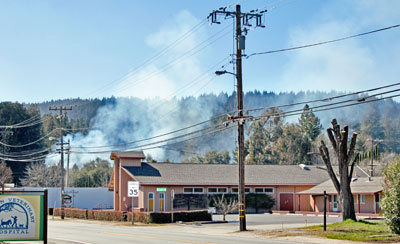
The San Lorenzo Valley has everything a nature lover could want: picturesque scenery, tall trees, fresh mountain streams. When it comes to air quality, however, the valley might be more akin to the Los Angeles Basin.
During the winter months, smoke levels in the San Lorenzo Valley have risen to — and more or less consistently remained at — levels that could be considered a health hazard, according to monitoring data collected by the Monterey Bay Unified Air Pollution Control District.
The elevated levels of smoke in the air are the result of frequent burning of leaves, brush and other plant debris; the density of homes that rely on woodstoves for heat; and the valley’s narrow topography, which often does not allow for proper air circulation to disperse the smoke, according to Richard Stedman, air pollution control officer with the air district.
“Think of it as a bowl, and inversion puts a lid on the bowl,” Stedman said. “The air cannot rise.”
In response to a series of complaints about smoke, the Monterey-based district began an intensive study on the air quality in the San Lorenzo Valley in November. The district set up three monitoring stations to determine the smoke levels: one at the Cal Fire station in Felton, another at San Lorenzo Valley Elementary School, also in Felton, and the third at the Ben Lomond fire station.
A fourth monitor is in Scotts Valley to serve as a comparison.
The concentration of monitors in a comparatively small area is a rarity for the district, Stedman said, as each monitor costs upward of $25,000.
“We would usually use just a few monitors to monitor an entire county,” he said. “We’ve known about this issue for a while; now, we have the money and the technology to dedicate to it.”
The three months of data collected so far have yielded some disturbing results. Nearly half of those days — 43 — yielded results that indicated smoke particulate levels considered dangerous to those with respiratory difficulties. The peak was on Christmas Day.
Mike Gilroy, deputy air pollution control officer for the district, said that’s a problem.
“This is the most pressing air-quality issue facing the tri-county region,” Gilroy said. “We just don’t see those numbers elsewhere.”
Stedman said the district would focus its efforts for the foreseeable future on ways to reduce the smoke levels. Tactics include education on safe burning techniques, public outreach, enforcement, and making alternatives to burning more accessible.
In 2011, the district granted a total of $75,000 to residents of Monterey, San Benito and Santa Cruz counties who switched to cleaner-burning fireplaces. More than half the money was awarded to 26 homes in the San Lorenzo Valley.
“It only takes one poorly ventilated stove to smoke out an entire neighborhood,” Stedman said. “Although they’re nice and warm, their neighbors can be smoked out.”
‘There’s too much smoke’
Boulder Creek resident Jeff Brown said the smoke gets so bad in his neighborhood that there are days he can’t go outside.
“No one wants to hear about more regulation,” he said. “But I can’t rake leaves, I can’t go outside — there’s just too much smoke.”
Brown said the smoke problem is nothing new. He recalled that when he worked at Boulder Creek Elementary School, smoke clouds from the surrounding areas were regularly seen on the playground.
“It gets to the point where you can’t tell if it’s a structure fire or a permissible burn day,” he said. “Sometimes you know they’re just burning trash.”
Brown said he regularly hauled leaves and brush from his land to the Ben Lomond Transfer Station, and he thought easier access to similar services might curtail yard burns.
“I live on 23 acres; there’s a whole lot of brush I could be burning,” he said. “But I think everyone wants to think that their grandkids will have clean air.”
In October, the district’s board of directors — composed of representatives from the governments of Santa Cruz, Monterey and San Benito counties — declared a legal ban on burning leaf piles.
“You couldn’t find a better smoke generator. You’re basically transferring all that brush into the air,” Stedman said. “If it’s smoldering and you can’t stand next to it, that’s too much smoke.”
Gilroy said that the district, which can legally issue fines against those burning illegally, would increase its presence in the valley, with an initial focus on creating awareness of the rules, rather than ticketing.
“Our initial response from people in the valley is they just weren’t aware of the proper ways to burn,” said David Frisbey, air quality inspector with the district. “Most people in general don’t want to hurt their neighbors.”
Stedman acknowledged that for some people, a government agency telling them what can and cannot be burned might be a tough sell.
“We appreciate that some people believe that burning is a right,” he said. “We understand that this is how things have been done for many, many years.”
Mark Stone, 5th District county supervisor, said he was glad to see the district addressing smoke problems in the valley, but he stressed the need to treat woodstoves and leaf burning independently.
“We need to separate those two issues, because there are a lot of people that use woodstoves for heat,” he said.
Supervisor Neal Coonerty, who serves on the air district’s board of directors with fellow Supervisor Ellen Pirie, said he was going to encourage the district — which meets in Monterey — to have one of its monthly meetings in the San Lorenzo Valley, to make it easier for residents to voice their concerns and ideas.
The Monterey Bay Unified Air Pollution Control District meets the third Wednesday of each month at 24580 Silver Cloud Court in Monterey.
For information: 647-9411.












